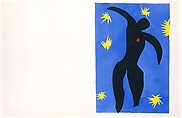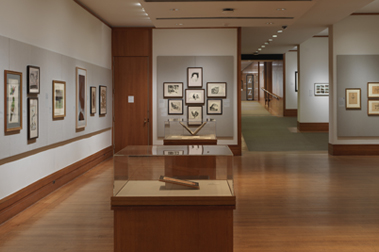Icarus, plate VIII from the illustrated book "Jazz"
Not on view
In Jazz, Henri Matisse employed an unorthodox and distinct visual vocabulary to radically rethink what an illustrated book could be. The project began in 1943 when Matisse created a series of cut-outs with the goal of creating an illustrated book. The process of the cut-outs, which he described as "drawing with scissors," involved him cutting directly into sheets of paper painted in vivid tones to create forms, which he then arranged in compositions. As color was a chief concern, Matisse used the stencil technique of pochoir for the prints to replicate the bold hues of the cut-outs.
Comprising twenty plates, Jazz depicts scenes of the circus, travels, mythology, and fairy tales, yet despite the stunning and intense colors (which Matisse later described as "vivid and violent tones"), the rhythmic juxtapositions of forms, the undulating lines, and the ostensibly joyous subjects, Jazz is haunted by a deep sense of danger, loss, and dread. It was begun during World War II after France had fallen to the Nazis and citizens were separated from their families, arrested, and even killed, in addition to experiencing severe deprivations of even the most basic necessities. Several members of Matisse’s family were active in the Resistance and in great danger, especially after they were captured, imprisoned, and tortured. Matisse, who had stayed in France, became gravely ill in 1941 and nearly died. The surgery that saved his life left him weak and severely restricted his mobility. It was during this period that he began to focus on cut-outs and, in 1943, he started work of Jazz.
While titles connote specific activities, places, and myths, the images contain multiple references and transcend specific narratives. Icarus has multiple connotations, including a trapeze artist in a circus, the Greek myth, and perhaps Matisse himself. It also recalls a figure who has been killed, either through gunshot (symbolized by the red circle on his chest) or bombs (represented by the jagged yellow forms that surround him), a thought reflected in the comments of the Surrealist writer Louis Aragon, who described the figure in the cut-out The Fall of Icarus, on which the print is based as being "like a corpse, and, from what Matisse said himself, it seems that the splashes of yellow—suns or stars if you want to be mythological—were exploding shells in 1943." Similarly, the red plant-like forms on the figure in The Clown read as both decoration and scars or wounds. Despite its ostensible joyfulness, the threat of danger and death pervades the work, as seen in images such as Pierrot’s Funeral (perhaps a reference to Matisse’s own brush with death), The Knife Thrower, and The Sword Swallower, in addition to Icarus. The Cowboy; The Horse, Rider and Clown, and The Nightmare of the White Elephant convey a sense of confinement, captivity, anguish, and brutality through the undulating whips and lassos and the jagged red forms that seem to pierce the body of the elephant, who precariously balances on a small ball. In multiple prints, such as Icarus, The Clown, The Swimmer in the Tank and Toboggan, figures appear as if they are moving through space, perhaps even in a fatal fall.
With Jazz, Matisse created a powerful and poetic work in which multiple, often contradictory, themes are engaged concurrently. Made under the horrific circumstances of war, illness, and separation from his family, he nevertheless created a piece that both responded to, and reflected on, these extreme conditions as well as well as presented visually stunning, boldly colored images that recalled memories from different times and places that could, perhaps, offer a moment of reflection and even joy.
This image cannot be enlarged, viewed at full screen, or downloaded.
This artwork is meant to be viewed from right to left. Scroll left to view more.



.R.jpg)
